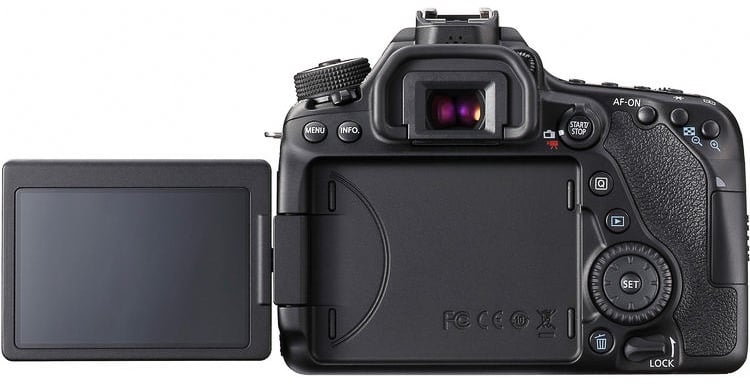Handling and Ergonomics
As a whole, the Canon 80D handles very well. For advanced users in particular, the camera is very functional and easy to use, giving off a sense of solidity and thoughtful design. It isn’t missing any buttons that you would expect to see on a camera of this class, and Canon’s menu system is still, in my opinion, among the best you’ll find on a camera today.
However, Canon is arguably a little too confident in the layout of the 80D, since there is not as much room to reprogram buttons to fit your needs as you may like. For example, one customization it is missing is the option to immediately recall the top setting in your “My Menu.” Nikon lets you assign a button to do exactly this, and it’s a noticeable advantage over the 80D. (Personally, I use it to change my Auto ISO settings more quickly, but the flexibility is that it lets you access essentially any setting you choose via one click.)

There are two other issues with the Canon 80D’s ease of use that are worth pointing out. First, because the camera’s tilt screen flips out to the side, there is not as much space to put buttons along the left-hand side of the camera. This means that the controls can get a bit crowded on the right-hand side and top of the camera, making it easy to press the wrong one if you aren’t totally familiar with the layout. The issue is compounded by the identical shape, size, and feel of the buttons; if you aren’t instinctively familiar with the 80D’s layout, you may need to take your eye away from the viewfinder to be sure which one you’re pressing.
Also, the buttons are not optimized for shooting while wearing gloves. Unlike some cameras (again, Nikon’s lineup), you can’t press the right-hand arrow on the direction pad to make a menu selection. You need to press the SET button in the center, which isn’t easy with thick gloves. Along with that, some of the buttons at the top are small and sunken, making them harder to press them with gloves as well (or find them by feel in the first place).

I still prefer the Canon 80D by a wide margin compared to lower-end DSLR and mirrorless options on the market, which have a serious lack of buttons and menu options. With the 80D, you won’t need to enter the menu very often to adjust important settings, which is a big deal.
On balance, the ergonomics on this camera are very good, but they fall slightly short of best-in-class. Still, at $1000 (body only), it is one of the least expensive cameras on today’s market to offer a “professional” control layout, and the end result is a camera that punches above its price in many ways.
Build Quality
The Canon 80D is built well. The relatively lightweight polycarbonate/magnesium body feels very sturdy in-hand. Even as a dedicated Nikon user, I have to say that the Canon 80D feels better than many Nikon cameras, including the competing D7500. This is largely due to the quality of the grip material, as well as the more curved and tailored nature of the camera body itself. (Note that this is not taking things like button layout and speed of use into account, where I still consider the Nikon D7500 to be the winner – just build quality and feel.)
The Canon 80D is weather sealed, and it shows. I used it in very sandy conditions with dust flying everywhere, and the 80D emerged unscathed. However, it is worth noting that the nature of the flip-out LCD is that dust, sand, dirt, etc., can get stuck in the compartment behind the screen fairly easily, and this might build up over the years. This is true of any camera with such a flexible articulating screen, not just the 80D.

Mechanically, the hinge for adjusting the LCD seems fine and completely sturdy. Some people get concerned that this type of tilt screen is more prone to damage than a stationary screen, or a screen that only articulates up and down. That’s a fair point, especially if you are concerned about dropping the 80D with the screen open. However, I wouldn’t consider it a cause for concern, especially because the screen’s added flexibility is a more important factor for most needs.
The screen on the 80D is not quite as large as some others on the market (3 inches diagonal versus 3.2 inches on others), but it makes up for things by being very high in quality. The LCD is sharp, of course, but it also has an uncanny ability to make photos look exceptionally good when you review them. This is not simply a product of Canon’s JPEG settings or something similar; the screen itself is calibrated differently than Nikon’s offerings, with more saturation and magenta tones that look very good upon reviewing a photo. When I tested this camera side-by-side against some of Nikon’s competing DSLRs, it led to the humorous result that I thought I was a better photographer with the Canon! Just when I was all set to sell my Nikon gear, I loaded the photos into a RAW processor and realized that the actual results were basically the same. Oh well.

Also, the “cheap” 18-55mm kit lens that you can buy with the 80D really impressed me in quality. It’s small, lightweight, and has two switches (image stabilization and auto/manual focus) rather than relying on changing image stabilization in the menu like Nikon now does with its kit lenses. Canon’s 18-55mm also lets you focus manually when setting to autofocus, which is excellent (and, again, unlike Nikon’s 18-55mm). Lastly, it doesn’t force you to “lock” it to collapse the lens as small as it gets for traveling. Oh, and it’s just as sharp as the Nikon version – but that is secondary to the ergonomics in importance!
Table of Contents